Day of the week by date before and after the Gregorian reform

History of the Julian and Gregorian calendars
In the 1st century BC, Gaius Julius Caesar introduced the Julian calendar. It was a reform of the original Roman calendar. Compared to the solar year, the calendar year was delayed by 11 minutes and 14 seconds each year. When a full day was added every four years, it was 44 minutes and 52 seconds more than it should have been, and thus the new year was celebrated the aforementioned time later than it actually began. By the end of the Common Era, this deviation amounted to about three-quarters of a day, by the end of the 4th century it was already three days, in the 13th century it was seven, and in the 16th century even ten days. At the time of the introduction of the Julian calendar, the vernal equinox was on March 25, at the time of the First Council of Nicaea (in 325) it fell on March 21, which then remained the fixed date of the vernal equinox, because it was very important in determining the date of Easter and other movable church holidays. However, in the 16th century, the true vernal equinox fell on March 11 and the autumnal equinox on September 11, with the shortest day being December 11 and the longest being June 11.
Such a deviation was too noticeable to be ignored, and throughout the Middle Ages many tried to eliminate it. However, to do this, it was necessary not only to determine the exact deviation caused by the shortcomings of the Julian calendar, but also to find a practical way to avoid it in the future. That is why the reform was delayed, although it was increasingly necessary. The main thing was to ensure that the vernal equinox fell on March 21 again. This matter was also addressed by church councils - Basel, the Fifth Lateran, and Trent in 1563.
In 1582, this effort was completed by Pope Gregory XIII, after whom the new calendar received its name – the Gregorian. However, it was designed by the Neapolitan physicist and astronomer Aloysius Lilius (c. 1510–1576), solving two key problems – eliminating the ten-day time difference and preventing it from happening again in the future by introducing leap years.
The first problem was easily solved. The ten extra days were simply dropped, bringing the calendar into line with the expected situation. Gregory XIII, in the papal bull Inter gravissimas of February 24, 1582, ordered that October 4, 1582, be immediately followed by October 15.
To prevent such a deviation from occurring again, it was decided to omit three leap years every four centuries, thus preventing the accumulation of three extra days during this period. Specifically, this meant that years at the end of centuries were leap years only if they were divisible by 400 without a remainder, e.g. 1600, 2000, 2400, etc. But 1700, 1800, 1900, 2100, etc. were non-leap years.
The Gregorian calendar, also called the "new" or "new style", was adopted by most Catholic countries almost immediately, mostly between 1582 and 1584. In Bohemia and Moravia it was probably in 1584, in Slovakia about three years later. Non-Catholic countries adopted it very slowly. Protestant areas of Germany accepted it partially in 1700 and completely only in 1775. Great Britain and its overseas colonies introduced it in 1752, when the deviation was already eleven days. For them, therefore, September 14 came after September 2, 1752. Japan did not adopt it until 1873.
The situation is peculiar in countries professing the Orthodox religion. They officially adopted it only in the twentieth century (e.g. Russia in 1918 and Greece only in 1923). However, while the Gregorian calendar is in force for civil purposes, the Julian calendar or a combination of the Julian and Gregorian calendars continues to be used for church purposes.
The astronomical basis of the Gregorian calendar and the Julian date
